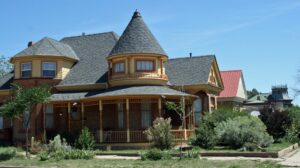In contrast to the Italianate style, which was common in "main street" commercial buildings and storefronts, the Queen Anne style (named for another English monarch) was a popular residential style in America and frontier towns in the 1890s and early 20th Century. Known for its complex decorative effects of wooden siding and shingles, wrap-around front porch, stained glass, eccentric rooms and roof shapes, the Queen Anne style was a favorite of prosperous merchants and civic leaders. Later the Queen Anne style was fused with classical forms for a more refined and stately design.
- Posts: 6 -
Artesia Historical Museum and Art Center

Constructed 1905. The Artesia Historical Museum & Art Center is housed in the 1905 Moore-Ward cobblestone house, built using river rocks from the Rio Penasco just south of town. A wide variety of exhibits and objects are on display, including Native American artifacts, farm and ranch tools, early oil and Read more…
Carnegie Park Historic District

The Carnegie Park Historic District is listed on the state and national registers and preserves the architectural fabric and eclecticism of the Gilded Age in New Mexico. With the boomtown prosperity of the railroad economy, Las Vegas attracted many prosperous merchants and entrepreneurs, some of whom made their homes near Read more…
Downtown Roswell Historic District

Constructed 1900. Original houses in the Roswell area were made of adobe or even sod. Log cabins were rare as the closest trees grew in the mountains 75 miles to the west, until settlers began planting them around their new homes. The arrival of the railroad in 1894 allowed building Read more…
Huning Highland Historic District

Constructed 1920. The Huning Highland district was Albuquerque’s first platted subdivision beyond the downtown area in the early 20th century. Doctors, merchants and teachers moved to the area, where the predominant architecture was in the Queen Anne style. In the 1920s, Albuquerque’s suburbs expanded east. Huning Highland was designated a Read more…
North New Town Residential Historic District

Constructed 1900 The large residential neighborhood north of Carnegie Park and east of the campus of New Mexico Highlands University contains a dazzling variety of historic residences reflecting nearly every popular historic architectural style during the gilded age of Las Vegas, 1890-1920. Many of the city’s leading citizens built homes Read more…
Original Townsite Historic District

Constructed 1880. The original 320 acres for the Raton townsite were purchased from the Maxwell Land Grant in 1880. In 1879, the Atchison, Topeka and Santa Fe Railroad bought a local toll road from famed frontier entrepreneur “Uncle Dick” Wooton and established a busy rail line. Raton quickly developed as Read more…